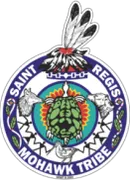The U.S. Environmental Protection Agency has said that they will release their Record of Decision (ROD) on Friday April 5, 2013 for the Grasse River cleanup. During a conference call on Thursday April 4, 2013, they indicated to tribal officials that they would be implementing Remedial Option number six which calls for a combination of dredging and capping. This would leave 93 percent of the contaminants in place. The estimated cost of this clean-up would be approximately $243 million. Alcoa will be responsible for bearing this cost. Tribal Chief Ron LaFrance expressed his disappointment with the decision, “I'm disappointed that the EPA would choose such a poor remedy that isn't a permanent solution. Their mission has been compromised so industrial pollution perpetrators can continue to violate the environment with little or no conscience. What's even sadder is that jobs won out over the health of the people; jobs that never benefited our community anyway.”
Beginning in the 1950s, Alcoa and Reynolds Metals Corporation discharged pollutants into the river system ultimately contaminating portions of the St. Lawrence River and its tributaries. The discharge of PCBs is one of the chief concerns because they are so persistent, are cancer-causing and take a very long time to break down in the environment. The PCBs have found their way into the food chain by infiltrating river sediments. They then contaminate smaller organisms which are eaten by larger and larger predators, and eventually are consumed by humans. Research has shown that PCBs are then found in human tissue and breast milk which is then passed on to infants.
Remedial Option Six calls for partially dredging the parts of the river shore and capping a portion of the river bottom with layers of sand, silt, gravel and armor stone. The other portion of the river bottom will be capped with sand, silt, but no gravel or armor stone. “The EPA has never sufficiently explained or justified the proposed capping remedy,” said Ken Jock, Director of the Tribe’s Environment Division.
“The EPA has a record of poor stewardship in protecting our environment, with the General Motor’s partial clean-up, the Reynolds partial clean-up and now with the Alcoa partial clean-up,” remarked Tribal Chief Paul Thompson. “That is still our land and the EPA should be using our standards for clean-up, not what the Alcoa scientists say should be done.” The Tribal Council supports Remedial Option Number 10, which called for dredging of the river bottom to completely remove the contaminants.
“We will continue to monitor the remedy and we ask EPA to require a perpetual monitoring and maintenance fund be set up just for the Grasse River remedy,” said Randy Hart, Tribal Chief. “If the remedy is not effective Alcoa must go back into the river and fix it.”
# # # #
For more information contact the Public Information Office at 518-358-2272.

